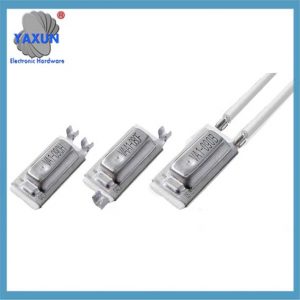เทอร์โมสแตทแบบ snap-action/ตัวป้องกันความร้อนที่มีอัตราการสัมผัสสูงสุดในบรรดาส่วนควบคุมของเรา. เหมาะสำหรับใช้งานบน 120/240 โหลด VAC. มีให้เลือกใช้องค์ประกอบไบเมทัลลิกหลากหลายเพื่อเพิ่มคุณลักษณะด้านประสิทธิภาพ. การเลือกตัวป้องกันความร้อนแบบ Creep-Action จำเป็นต้องมีการวิเคราะห์ข้อกำหนดจำเพาะของเสาแล้วโยน, อุณหภูมิจุดที่ตั้งไว้, ฮิสเทรีซีส, พิกัดกระแสสูงสุด, อัตราแรงดันไฟฟ้ากระแสสลับสูงสุด, อัตราแรงดันไฟฟ้ากระแสตรงสูงสุด, และเปลี่ยนชีวิต.
Pole-and-throw specifications
Single pole, โยนครั้งเดียว (SPST) switches make or break the connection of a single conductor in a single branch circuit. They have two terminals and are commonly referred to as “single pole” switches.
Single pole, double throw (SPDT) switches make or break the connection of a single conductor with either of two other single conductors. Often called “three-way switches,” SPDT devices have three terminals and are used in pairs.
Double pole, โยนครั้งเดียว (DPST) switches make or break the connection of two circuit conductors in a single branch circuit and usually have four terminals.
Double pole, double throw (DPDT) switches make or break the connection of two conductors in two separate circuits. Most DPDT switches have six terminals and are available in either momentary or maintained contact versions.
Creep-Action Thermal Protectors with more than two poles are designed to split loads into separate circuits.
Creep-Action Thermal Protectors Set-point Temperature
Creep-Action Thermal Protectors Specification Guide Thermal switches and thermal protectors have a set point temperature that is either fixed or field adjustable. The set point is the rated temperature at which the device undergoes a change in state associated with movement of the electrical contacts. Fixed-point devices are rated at a given temperature while field-adjustable devices have a temperature range over which the set point can be adjusted.
Creep-Action Thermal Protectors Hysteresis
Hysteresis, also referred to as the temperature differential, is a finite temperature range over which switching takes place. It is designed to prevent circuitry from constantly changing between states. A hysteresis of 0.5 C will typically actuate 0.5 degrees past the set-point temperature and not change state again until the temperature drops to 0.5C below the set-point temperature.
อุณหภูมิแวดล้อม: The normal or typical temperature of the environment surrounding the device.
Automatic Reset: A thermostat that automatically resets to its pre-trip contact configuration at a factory preset temperature.
ไบเมทัลลิก: Two metals with different rates of expansion molecularly bonded together to form a blade or disc for a thermostat.
Creep Action Thermostat: A thermostat with a bimetal blade that slowly makes the contacts or slowly breaks the contacts.
Current Derating: Term used to describe a predictable condition where increased current applied to a thermostat causes the device to open at a temperature below its set point. This condition is present only in Normally Closed bimetal thermostats that are both current and temperature sensitive.
Functioning Temperature: (TF of Tf) In reference to a thermal cutoff, as defined by IEC Standards, the temperature at which a Thermal Cutoff opens a circuit under a no load condition. The IEC tolerance is +0 ค, -10 ค.
Holding Temperature: (TH or Th) In reference to a thermal cutoff, the maximum temperature that a Thermal Cutoff can maintain Rated Current for a period of 168 hours with functioning.
Maximum Temperature: (TM or Tm) In reference to a thermal cutoff, the maximum temperature to which the device can be subjected for a period of ten minutes without resuming conductivity once it has opened.
Minimum Differential: (also known as deadband) The minimum number of degrees between the actual open and actual close temperatures.
Motor Protector: A thermal protector that is sensitive to both increases in current and increases in temperature.
ปกติปิด (N.C.): Contacts open on temperature rise.
เปิดตามปกติ (N.O.): Contacts close on temperature rise.
One Shot: A device that, once activated at its preset temperature, cannot be reset. Available only in Normally Closed contact configuration.
จัดอันดับปัจจุบัน: The maximum allowable current that a device can carry.
แรงดันไฟฟ้าที่ได้รับการจัดอันดับ: The maximum voltage that should be applied to a device.
Self-Hold Protector: A device that, upon opening, will not reset until power is removed from its circuit regardless of ambient temperature. Available only in Normally Closed contact configuration.
Snap Action Thermostat: A thermostat with a Bimetal element that snaps to close the contacts when the activation condition is experienced. This construction permits the clean break of loads.
ตัวตัดความร้อน: A thermal cutoff is an electrical safety device that interrupts electric current when heated to a specific temperature.
Thermal Cutoff Fuse: A device that melts its internal element to open a circuit in an over-temperature condition. Also known as a thermal fuse, thermal protector fuse or thermal switch.
Thermal Protector: A Thermal Protector is a protective device built into a motor that provides over-current or over-temperature protection that disconnects power to the ballast if internal temperatures rise above the trip point. This protects motors from overheating. Types of switches include automatic rest, manual reset and resistance temperature detectors.
ความอดทน: The allowable range above and below a nominal temperature.
 English
English العربية
العربية Български
Български 粤语
粤语 中文(简体)
中文(简体) 中文(漢字)
中文(漢字) Nederlands
Nederlands Suomi
Suomi Français
Français Deutsch
Deutsch Ελληνικά
Ελληνικά Magyar
Magyar Italiano
Italiano 日本語
日本語 한국어
한국어 Polski
Polski Português
Português Română
Română Русский
Русский Slovenščina
Slovenščina Español
Español Svenska
Svenska ภาษาไทย
ภาษาไทย Türkçe
Türkçe Tiếng Việt
Tiếng Việt



